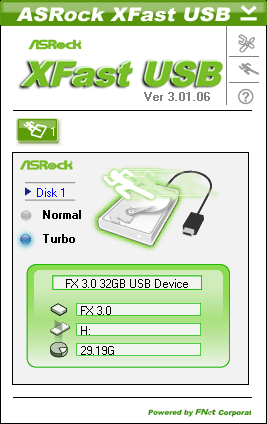ASRock P67 Pro3 (B3) Motherboard
|
Bundle and software
ASRock P67 Pro3 comes with a minimal bundle: two SATA cables with latches (one with an L-shaped connector), a backpanel faceplate, brief manuals for the motherboard and UEFI, and a software DVD.
ASRock followed the example of other major board makers and unified all utilities into one suite, where Extreme Tuning Utility (XTU) is the key tool. Also provided are XFast USB and App Charger. The latter doesn't have a GUI of its own, but installs as a driver and provides power to charge USB devices from the standard +5V in any PC power state, including S5 (turned off completely). Besides, connected devices may be fed higher current, if possible, to speed up charging.
XFast USB is a third-party utility that enables a 'turbo' mode for data exchange over USB. It's small, simple, and it works. There are many similar solutions, and this one hardly offers anything except advanced caching policies. A quick test indicated that copying a lot of small files onto a fast USB drive over USB 3.0 was about 10% faster (not a few times faster, as ASRock says on its website). Copying one large file was naturally the same in both Turbo and Normal modes.
The XTU utility provides all typical low-level features: overclockers (within the aforementioned moderate limits), monitors temperatures, voltages and rotation speeds, adjusts system fans (not very flexibly though), provides access to BIOS profiles, etc. While there are better solutions in the market — in terms of both interface and features (e.g. MSI Control Center) — XTU can really be helpful and must be developed further.
Features
The backpanel has everything a modern user may need: 2 x USB 3.0, 6 x USB 2.0, eSATA, audio I/O, the Clear CMOS button. Owners of older peripherals will be pleased to see two PS/2 connectors as well.
ASRock P67 Pro3 is based on the Intel P67 PCH and has controllers listed below.
- USB 3.0 based on EtronTech EJ168A (PCIe x1), supports 2 devices.
- Integrated audio based on the 7.1+2-channel Realtek ALC892 HDA codec. An optical (Toslink) and a coaxial S/PDIF-Out on the backpanel, another S/PDIF-Out on the PCB.
- Gigabit Ethernet based on Realtek RTL8111E (PCIe x1).
- PCI based on the ASMedia ASM1083 PCIe-PCI bridge, 3 expansion slots.
Note that the backpanel eSATA port, it's actually shared with one of the onboard SATA-600 ports.
The digital S/PDIF-Out supports both 44.1 and 48 kHz sampling rates. The used audio codec doesn't offer any interesting surround sound technologies, so we'll just test its analog outputs in the 16-bit/44kHz and 16-bit/48kHz modes with RightMark Audio Analyzer 6.0 and Terratec DMX 6fire.
| Test |
16-bit/44kHz |
16-bit/48kHz |
| Frequency response (40Hz to 15kHz), dB: |
+0.01, -0.02 |
+0.01, -0.02 |
| Noise level, dB(A) |
-93.4 |
-93.5 |
| Dynamic range, dB(A) |
93.4 |
93.6 |
| THD, % |
0.0030 |
0.0029 |
| THD + noise, dB(A) |
-78.7 |
-79.0 |
| IMD + noise, % |
0.013 |
0.014 |
| Channel crosstalk, dB |
-91.9 |
-90.6 |
| IMD at 10 kHz, % |
0.010 |
0.0098 |
| Overall grade |
Very good |
Very good |
When testing ASRock P67 Pro3 we for the first time encountered an issue related to PCI support. The motherboard repeatedly 'lost' our PCI sound card or refused to boot up when it was installed. Rebooting and re-installing helped temporarily, but the problem was solved only when we removed the PCI hard drive controller. Interestingly enough, ASRock P67 Pro3 has the same ASMedia ASM1083 PCI-PCIe bridge as those ASUS and MSI motherboards we tested before. And they worked fine with the same sound card and PCI hard drive controller. So we hope that perhaps newer firmware will have this bug fixed.
Conclusions
ASRock P67 Pro3 is a rather inexpensive LGA 1155 motherboard that mostly offers basic features of this platform, but has decent expandability. It won't do for a SLI/CrossFire configuration and may require additional expansion cards, if onboard connectors are not enough. If they are, you get a decent motherboard with matching software utilities that will let you build a good modern PC.
Write a comment below. No registration needed!
|
|
 |
|
|
|

